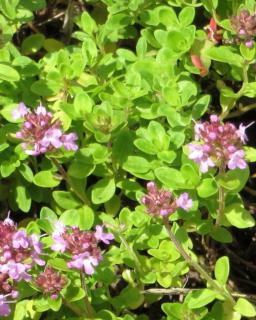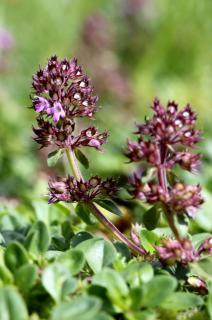

Wild thyme is a low-lying perennial that is as useful as a herb as it is ornamental.
Key Wild Thyme facts
Name – Thymus serpyllum
Family – Lamiaceae
Type – creeping plant, cover plant
Height – 1 ½ feet (15 cm)
Exposure – full sun
Soil: light, well-drained – Foliage: evergreen – Flowering: summer
Pink blossoms and tasty evergreen foliage are part of its appeal all year round.
Wild thyme is a perfect plant to cover the ground, since it crawls with dense leafage. It adapts well to rocky ground, along edges of flower beds, and also grows well in pots and in nooks of a stone wall.

If you have prepared seedlings in a nursery, you can transplant the seedlings in the ground 5 to 6 weeks after sprouting.
The best season to plant your wild thyme is spring or at the end of summer.
Wild thyme can be propagated through crown division at the beginning of spring.

Help your slow-growing wild thyme by weeding around it to stifle out competition.
You can cut stems off your wild thyme whenever you need some all year round.
It is best to cut stems from recent growth to stimulate appearance of new shoots.
It is best to select the younger stems and collect them in the morning before dawn, which is when flavors are most concentrated.
Both flowers and leaves are used. They can be eaten cooked or raw, they are delicious when fresh.
Wild thyme leaves, just like common thyme, are perfect for seasoning barbecues, gravy, fish and even infusions.
Wild thyme flowers are also used for their fragrance, although not as intense as in leaves. They make up for this with their beauty, and are edible ornaments to all meals, especially salads.
A few flowers sprinkled on grilled meat or atop a mixed salad are beautiful!
There are two ways to keep it, either leaves are dried, or they are frozen in a freezer.
In the first case, place collected wild thyme stems in a dry and ventilated place until they are completely dry. After that, they can be ground and kept in a jar for several months.
Freezing has the advantage of preserving their flavor, and thyme can keep this way for several months.
Wild thyme is one of the most beautiful kinds of thyme. It flowers abundantly all summer long, and produces cute little flowers in hues of pale pink to bright pink.
It is often used in infusions, and also in cooking to flavor sauces and soups.
Native to the Mediterranean area, wild thyme is very fragrant and is particularly well suited to seasoning grilled meat and fish.
As a garden helper, it will repel the large white butterfly that destroys cabbage patches.
No need to water, wild thyme will be perfectly happy with poor and dry soil. It naturally grows in desolate arid places.